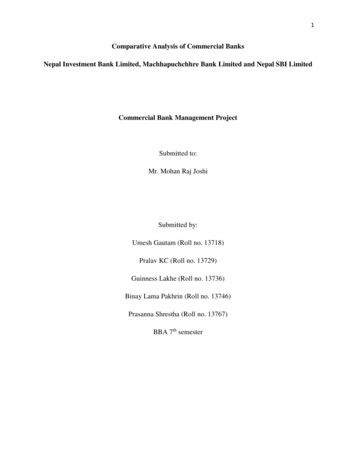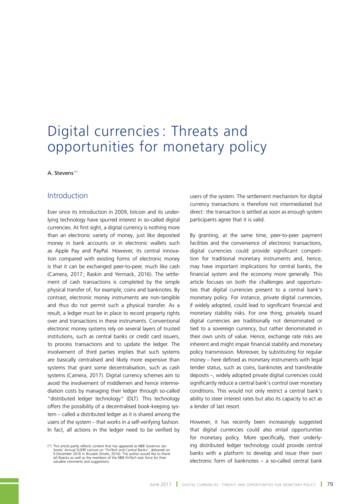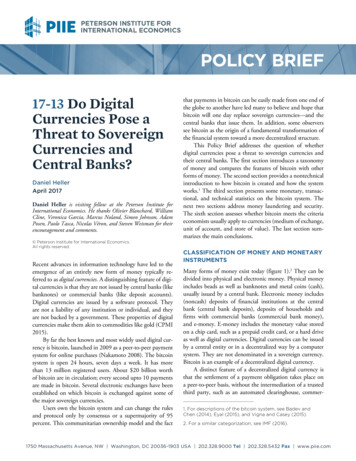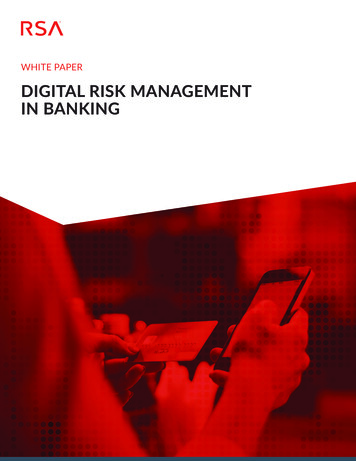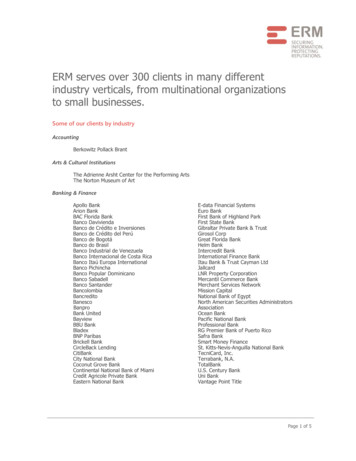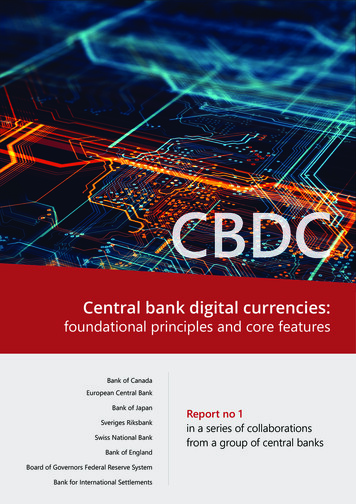
Transcription
Central bank digital currencies:foundational principles and core featuresBank of CanadaEuropean Central BankBank of JapanSveriges RiksbankSwiss National BankBank of EnglandBoard of Governors Federal Reserve SystemBank for International SettlementsReport no 1in a series of collaborationsfrom a group of central banks
This publication is available on the BIS website (www.bis.org). Bank for International Settlements 2020. All rights reserved. Brief excerpts may be reproduced ortranslated provided the source is stated.ISBN: 978-92-9259-427-5 (online)
ContentsExecutive summary . 11.Introduction . 21.1The report . 31.2CBDC explained . 3“Synthetic CBDC” is not a CBDC . 42.Motivations, challenges and risks. 52.1Payment motivations and challenges . 5Cross-border payments and CBDC . 72.2Monetary policy motivations and risks . 82.3Financial stability risks. 82.4Balancing motivations and risks . 93Issuing a CBDC . 103.1Three foundational principles . 103.2Core features . 1145.CBDC design and technology . 124.1Design choices . 124.2Technology considerations . 134.3Key trade-offs . 15Concluding thoughts and next steps . 16References . 18Annex A: Questions to guide further research . 19Annex B: Group members . 20Central bank digital currencies: foundational principles and core featuresi
Executive summaryCentral banks have been providing trusted money to the public for hundreds of years as part of theirpublic policy objectives. Trusted money is a public good. It offers a common unit of account, store of valueand medium of exchange for the sale of goods and services and settlement of financial transactions.Providing cash for public use is an important tool for central banks.Yet the world is changing. Even before Covid-19, cash use in payments was declining in someadvanced economies. Commercially provided, fast and convenient digital payments have grownenormously in volume and diversity. To evolve and pursue their public policy objectives in a digital world,central banks are actively researching the pros and cons of offering a digital currency to the public (a“general purpose” central bank digital currency (CBDC)). Understanding of CBDCs has advancedsignificantly in the last few years. Published research, policy work and proofs-of-concept from centralbanks have gone a long way towards establishing the potential benefits and risks.For the central banks contributing to this report, the common motivation for exploring a generalpurpose CBDC is its use as a means of payment. Providing cash to the public is a core responsibility ofcentral banks and a public good. All the contributing central banks commit to continue providing cash aslong as there is public demand. Yet a CBDC could provide a complementary central bank money to thepublic, supporting a more resilient and diverse domestic payment system. It might also offer opportunitiesnot possible with cash while supporting innovation.CBDC issuance and design are sovereign decisions to be made by each jurisdiction. This reportis not about if or when to issue a CBDC. Central banks will make that decision for their jurisdictions (inconsultation with governments and stakeholders). None of the central banks contributing to this reporthave reached a decision on whether or not to issue a CBDC. Instead, this report advances the foundationalinternational work by outlining common principles and the key features a CBDC and supportinginfrastructure would need in order to contribute to central bank public policy objectives.The principles emphasise that: (i) a central bank should not compromise monetary or financialstability by issuing a CBDC; (ii) a CBDC would need to coexist with and complement existing forms ofmoney; and (iii) a CBDC should promote innovation and efficiency. The possible adverse impact of a CBDCon bank funding and financial intermediation, including the potential for destabilising runs into centralbank money, has been a concern of central banks. Any decision to launch a CBDC would depend on aninformed judgment that these risks can be managed, likely through some combination of safeguardsincorporated in the design of a CBDC and financial system policies more generally. Understanding thepotential market structure effects of CBDC, their implications for financial stability, and any potentialmitigants is a further area of work for this group.A CBDC robustly meeting these criteria and delivering the features set out by this group couldbe an important instrument for central banks to deliver their public policy objectives.This potential, together with the agreement on common principles and features, means there isconsiderable scope for future international collaboration, knowledge-sharing and experimentation onCBDC. Simultaneous research and development of CBDC by central banks could also explore ways toimprove cross-border payments, as part of the G20 roadmap (CPMI (2020)), while avoiding spillovers andunintended consequences.The next stage of CBDC research and development will emphasise individual and collectivepractical policy analysis and applied technical experimentation by central banks. This report highlightsCBDC design and technology considerations, including initial thoughts on where trade-offs lie. Far morework is required to truly understand the many issues, including where and how a central bank should playCentral bank digital currencies: foundational principles and core features1
a direct role in an ecosystem and what the appropriate role might be for private participation. The speedof innovation in payments and money means that these questions are ever more urgent.A CBDC could be an important instrument for central banks to continue to provide a safe meansof payment in step with wider digitalisation of people’s day-to-day lives. Public trust in central banks iscentral to monetary and financial stability and the provision of the public good of a common unit ofaccount and secure store of value. To maintain that trust and understand if a CBDC has value to ajurisdiction, a central bank should proceed cautiously, openly and collaboratively.This group of central banks will continue to work actively and collaboratively on CBDC, furtherexploring the practical implications of the core features. Individually, the contributing central banks willcontinue outreach efforts in order to foster an open and informed dialogue with domestic stakeholderson CBDC. Collaboratively, we will also explore practical issues and challenges for broad interoperability ofdomestic CBDCs in accord with related international workstreams (eg the G20 roadmap on cross-borderpayments) We welcome further BIS information sharing on CBDC and BIS Innovation Hub plans to explorethe technologies that could support CBDCs.1.IntroductionCentral banks have a mandate for monetary and financial stability in their jurisdictions and, explicitly orimplicitly, to promote broad access to safe and efficient payments. A core instrument by which centralbanks carry out their public policy objectives is providing the safest form of money to banks, businessesand the public – central bank money.This money acts as a means of payment, unit of account and store of value for a jurisdiction. Acommon unit of account is a public good that allows goods and services to be exchanged and financialtransactions to be settled efficiently and safely. Today, central banks provide money to the public throughcash and to banks and other financial companies through reserve and settlement accounts. In this way,some of the smallest and largest payments in an economy are carried out using central bank money. Yetthe ongoing digitalisation of the economy is changing the way people pay. The use of cash, currently theonly form of central bank money available to the public, is falling in many jurisdictions. The Covid-19pandemic may be accelerating this trend. Taking cash’s place is private digital money and alternativepayment methods.Many central banks’ public policy objectives have remained broadly unchanged for the lasthundred years. Yet the significant changes of that period have required central banks to innovate andevolve in how they met their objectives. A potential further evolution being considered is through issuinga new form of money: central bank digital currency (CBDC). A recent survey found that 80% of centralbanks are engaged in investigating CBDC and half have progressed past conceptual research toexperimenting and running pilots (Graph 1). To coordinate and consolidate some of this work, the centralbanks of Canada, Japan, Sweden, Switzerland, the United Kingdom and the United States have cometogether, along with the European Central Bank and the Bank for International Settlements. This reportsummarises where they collectively stand.Arguments for and against issuing a CBDC and the design choices being considered are drivenby domestic circumstances. There will be no “one size fits all” CBDC. Yet domestic CBDCs would still haveinternational implications. Cooperation and coordination are essential to prevent negative internationalspillovers and simultaneously ensure that much needed improvements to cross-border payments are notoverlooked.2Central bank digital currencies: foundational principles and core features
Central banks continue to work on CBDCShare of respondentsEngagement in CBDC work1Graph 1Focus of workType of work in addition to research1Share of respondents conducting work on CBDC.Source: Boar et al (2020)1.1The reportThis report starts by examining central banks’ motivations and evaluates some of the opportunities drivingCBDC research. In this context, some foundational principles for central banks’ role in payment systemsare then articulated together with the core features required of any CBDC for it to fulfil public policyobjectives. To realise these core features, a suitable design for a CBDC and its underlying system must bedeveloped. This report highlights some of the key design choices and where the policy trade-offs andtechnology challenges currently lie for central banks. The report concludes with thoughts on future workand some recommendations for where and how international collaboration can aid future domestic policydiscussions.1.2CBDC explainedCBDC is “a digital form of central bank money that is different from balances in traditional reserve orsettlement accounts” (CPMI-MC (2018)). Interest in this new form of money is increasing and central banksare researching and experimenting with underlying technology. At the same time, private experimentswith new forms of digital money continue and the conceptual variety afforded by new technologies hasmeant that, although CBDC is well defined, this definition is not always well understood.A CBDC is a digital payment instrument, denominated in the national unit of account, that is adirect liability of the central bank. 1 This report focuses on broadly available general purpose CBDCs (ie thatcan be used by the public, for day-to-day payments rather than CBDCs restricted to wholesale, financialmarket payments).1Some commentators and academics have referred to “synthetic CBDCs”, which are the equivalent of narrow-bank money andnot a direct claim on a central bank. This is not a CBDC by definition and lacks the neutrality and liquidity of central bank money(Box 1). Similarly, a liability issued by a central bank that is not in its own currency (ie where it does not have monetary authority)is not a CBDC.Central bank digital currencies: foundational principles and core features3
Today, central banks issue two types of money and provide infrastructure to support a third.Physical cash and electronic central bank deposits, also known as reserves or settlement balances, areissued. Physical cash is widely accessible and peer-to-peer. In contrast, central bank reserves are electronicand typically only accessible to qualifying financial institutions. The third type of money is private money,principally available through widely accessible and electronic commercial bank deposits. Central bankssupport commercial bank money in various ways, by: (i) allowing commercial banks to settle interbankpayments using central bank money; (ii) enabling convertibility between commercial and central bankmoney through banknote provision; and (iii) offering contingent liquidity through the lender of last resortfunction. Importantly, while cash and reserves are a liability of the central bank, commercial bank depositsare not. CBDC would be a new type of central bank money.A general purpose CBDC would require an underlying system to provide and distribute itconveniently to the public. This system would comprise the central bank, operator(s), participatingpayment service providers and banks. 2 A wider ecosystem supporting the system could then include dataservice providers, companies providing and maintaining applications and providers of point of sale devicesto initiate and accept payments.Box 1“Synthetic CBDC” is not a CBDCA potential alternative framework under which central banks could engage with the rise of digital currencieswould be for private sector payment service providers to issue liabilities matched by funds held at the centralbank. Such an approach has been suggested by some stablecoin proposals and described in some papers as“synthetic CBDC” (eg Adrian and Mancini Griffoli (2019)).These payment service providers would act as intermediaries between the central bank and the endusers. If the regulatory framework can guarantee that these providers’ liabilities will always be fully matched byfunds at the central bank, these liabilities could share some of the characteristics of a CBDC issued by the centralbank. Yet these liabilities would not be a CBDC, as the end user would not hold a claim on the central bank. Theyare, essentially, a form of “narrow-bank” money. In addition to not being a CBDC by definition, these liabilities would also lack some key features ofcentral bank money. As described in Section 2.1.3, commercial payment service providers benefit from strongnetwork effects, potentially leading to concentration and monopolies or fragmentation. Central banks have publicpolicy, rather than profit objectives. This enables neutrality in providing services to users, allowing for an openand inclusive system.Another difference between CBDC and narrow-bank money is liquidity. Central banks can expand theirbalance sheets and create additional liabilities, at short notice, in response to underlying demand. By design, apayment service provider as described above cannot do this – every liability must be matched by funds held atthe central bank. This makes a CBDC more liquid than a matched claim on a private provider. For narrow-bankmoney, concerns about the existence of the underlying matched funds could cause doubts on the value of theliabilities and result in users selling them at a discount to the par value of the currency. This cannot occur with aCBDC.There might be a useful role for privately issued liabilities matched with central bank money in ajurisdiction’s payment system (Kahn et al (2018)). However, the necessary information and decision-makingprocess for a central bank to enable such an arrangement is very different from a consideration of issuing CBDC. The value of a financial system based on narrow banking or “full-reserve banking” has been debated for hundreds of years. Bossone(2001) provides an overview of the arguments.24Some of these entities could overlap, eg the central bank could operate the system.Central bank digital currencies: foundational principles and core features
2.Motivations, challenges and risks A variety of motivations drive central bank research into CBDC. Currently, the focus is on providing a CBDC for payments, enabling broad access to central bankmoney and providing resilience. Practical challenges and risks exist, which multiply when additional requirements are considered,eg improving cross-border payments or enabling monetary policy tools.There are a large and diverse number of motivations driving central banks’ interest in CBDCs. Differencesbetween emerging market economies and advanced economies are especially pronounced but individualjurisdictions can also vary significantly depending on their circumstances (Boar et al (2020)). For the centralbanks contributing to this report, the primary research motivation is a CBDC’s use as a means of payment,although there are secondary motivations (eg enhancing monetary policy tools). CBDC is not unique inbeing able to fulfil many of these motivations and CBDC designs are likely to require trade-offs that meannot all motivations can be realised simultaneously.2.1Payment motivations and challenges2.1.1Continued access to central bank moneyIn jurisdictions where access to cash is in decline, there is a danger that households and businesses will nolonger have access to risk-free central bank money. Some central banks consider it an obligation to providepublic access and that this access could be crucial for confidence in a currency. A CBDC could act like a“digital banknote” and could fulfil this obligation.2.1.2ResilienceCash serves as a backup payment method to electronic systems if those networks cease to function.However, if access to cash is marginalised, it will be less useful as a backup method if the need arises. ACBDC system could act as an additional payment method, improving operational resilience. 3 Comparedto cash, a CBDC system might provide a better means to distribute and use funds in geographically remotelocations or during natural disasters. However, significant offline capabilities would need to be developed,both for the CBDC system and any dependencies (eg some availability of electricity for mobile devices).Counterfeiting and cyber risk present a challenge. Cash has sophisticated anti-counterfeitingfeatures and large-scale issues rarely occur. Theoretically, a successful cyber attack on a digital CBDCsystem could quickly threaten a significant number of users and their confidence in the wider system (asit could for a large bank or payment service provider). Defending against cyber attacks will be made moredifficult as the number of endpoints in a general purpose CBDC system will be significantly larger thanthose of current wholesale central bank systems.2.1.3Increased payments diversityPayment systems, like other infrastructure, benefit from strong network effects, potentially leading toconcentration and monopolies or fragmentation. Payment service providers have the incentive to organisetheir platforms as closed-loop systems. When a small number of systems dominate, high barriers to entryand high costs (especially for merchants) can occur. Where more systems exist, fragmentation may stilloccur as systems often have proprietary messaging standards, increasing the cost and complexity of3However, this increase in resilience assumes that other payment methods and instruments remain available.Central bank digital currencies: foundational principles and core features5
interoperability (CPMI (2018)). Fragmentation of payment systems means that users and merchants mayface costs and difficulties paying users of other systems. This is inconvenient and socially inefficient. CBDCcould provide a common means to transfer between fragmented closed-loop systems (although anaccessible fast payment system can also achieve the same end). 42.1.4Encouraging financial inclusionFor the central banks contributing to this report, most of the adult population in their jurisdictions canconveniently access electronic payments. However, increasing digitalisation could leave some sections ofsociety behind as potential barriers around trust, digital literacy, access to IT and data privacy concernscreate a digital divide. For central banks in many emerging market economies, a key driver for researchingCBDC is the opportunity to improve financial inclusion (Boar et al (2020)).Yet for a CBDC to increase financial inclusion, it must address the causes of exclusion, which varyby jurisdiction and are often complex. 5 Given the complexity of this issue and possible underlying obstaclesto digital inclusion (eg illiteracy), any CBDC initiative would likely need to be embedded in a wider set ofreforms (CPMI-World Bank (2020)).2.1.5Improving cross-border paymentsCross-border payments are inherently more complex than purely domestic ones. They involve more, andin some cases numerous, players, time zones, jurisdictions and regulations. As a result, they are often slow,opaque and expensive (CPMI (2018)). An interoperable CBDC (ie one that is broadly compatible withothers) could play a role in improving cross-border payments (Box 2).2.1.6Supporting public privacyA key feature of cash is that no centralised records of holdings or transactions exist. Some have arguedthat the main benefit a CBDC could bring would be some level of anonymity for electronic payments (Bechand Garratt (2017)).Full anonymity is not plausible. While anti-money laundering and combating the financing ofterrorism (AML/CFT) requirements are not a core central bank objective and will not be the primarymotivation to issue a CBDC, central banks are expected to design CBDCs that conform to theserequirements (along with any other regulatory expectations or disclosure laws).For a CBDC and its system, payments data will exist, and a key national policy question will bedeciding who can access which parts of it and under what circumstances. 6 Striking this balance betweenpublic privacy (especially as data protection legislation continues to evolve) and reducing illegal activitywill require strong coordination with relevant domestic government agencies (eg tax authorities).2.1.7Facilitating fiscal transfersFor some jurisdictions, the Covid-19 pandemic illustrates the benefits of having efficient facilities for thegovernment to quickly transfer funds to the public and businesses in a crisis. A CBDC system with identifiedusers (eg a system linked to a national digital identity scheme) could be used for these payments.4At a user level, cash could theoretically fulfil the same function but transferring from electronic to physical and back to electronicmoney is costly and inconvenient. At a payment provider level, existing wholesale central bank payment systems already fulfilthis role. Yet not all payment service providers will be eligible or want to participate.5Causes of exclusion can include: (i) depository institutions being unable to offer profitable services to users in certaingeographies or at lower income levels; (ii) high requirements or costs for offered services (eg fees or travel time to branches);and (iii) other reasons, such as lack of trust in available depository institutions.6A possible model is one where personal and business data (eg users’ identities and transactions) would not be disclosed tothird parties or governments unless required by law, while maintaining capability to investigate (eg ECB and BoJ (2020)).6Central bank digital currencies: foundational principles and core features
Although a CBDC could play a role in making fiscal transfers more efficient (especially injurisdictions with greater unbanked populations), on its own, it would not be necessary or sufficient. Alinked digital identity system would be a necessity to realise real improvement. If such a system were inplace, the incremental benefit of CBDC over transfers to (eg) commercial accounts, etc could be small,depending on designs. Additionally, if fiscal transfers were made with CBDC there is a risk of blurring thedivision between monetary and fiscal policy and a potential reduction in monetary policy independence.Cross-border payments and CBDCBox 2The G20 has made enhancing cross-border payments a priority. CPMI (2020) identifies CBDC as one area ofinterest for making cross-border payments using central bank money more efficient. Although many of today’sCBDC projects and pilots have a primarily domestic focus (Auer et al (2020)), various bilateral experiments havedemonstrated the feasibility of using CBDCs for cross-border payments (eg ECB and BoJ (2019), BoC and MAS(2019), BoT and HKMA (2020)).CBDC could be used for cross-border payments in different ways. A domestic CBDC could be used forpayments from, to and perhaps even within another currency area. This could facilitate efficiency but may alsocreate risks for the foreign jurisdiction. Additionally, CBDC systems could be designed to interoperate to facilitatecross-border and cross-currency payments. Interoperability is a broadly understood term and potentially coversa multitude of different ways payment systems or arrangements can interact with one another. At a basic technicallevel, this can involve reducing the barriers to membership of both systems, eg through common messagingstandards and overlapping operating times. Moving beyond this, coordination between the systems can extendto common business arrangements, eg a designated settlement agent between the systems for certain payments.Another means is integration of the systems through an interoperable link where the infrastructures combinetheir functions (eg arrangements where there are multiple CBDCs (Auer et al (2020)).A future challenge with interoperability might be the number and diversity of payment systemsdomestically and internationally. CBDC systems will enter a crowded field of domestic payment systems andinteroperability can enable complementarity and coexistence. For cross-border payments, closed-loop systems(eg global stablecoins) can potentially offer some efficiencies but only if they interoperate with others (CPMI(2018)). Common international standards (eg ISO 20022) can help. Yet for CBDC systems, their additionalfunctionalities and future designs may require these standards to be enhanced and for central banks to workcollaboratively in their development. Similarly, if CBDC systems are linked with supplementary systems and dataservices (eg digital identity repositories), then commensurate international standards may be required forseamless cross-border payments. New systems based on different technologies (eg token-based) may alsopresent challenges.Interoperability between domestic CBDCs is, however, not just a question of technical design and workon common standards and interfaces. CPMI (2020) describes five “focus areas” to improve cross-border payments,of which only one involves exploring new payment infrastructure. Different legal and regulatory frameworkspresent a significant obstacle to cross-border payments. Harmonising these frameworks would be a challenge.Finally, monetary policy and financial stability implications related to cross-border CBDC arrangementsneed thorough analysis. Designing a CBDC that is convenient for cross-border payments could help adoption.Enabling easy access for tourists and foreign travellers could incentivis
banks have gone a long way towards establishing the potential benefits and risks. For the central banks contributing to this report, the common motivation for exploring a gen eral purpose CBDC is its use as a means of payment. Providing cash to the public is





